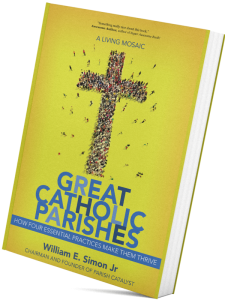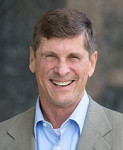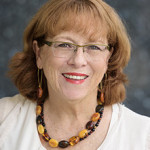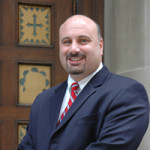William E. Simon, Jr., Great Catholic Parishes: A Living Mosaic: How Four Essential Practices Make Them Thrive (Notre Dame, IN: Ave Maria Press, 2016), ISBN-13: 978-1-59471-417-7. 178 pages + 10 pages of appendices, 10 pages of notes, and 4 pages of bibliography, for a total of 202 pages. $17.95.
Review by Mark F. Fischer
 William E. Simon Jr.’s Great Catholic Parishes does in 2016 what Paul Wilkes’ Excellent Catholic Parishes did in 2001: it recommends the best practices in U.S. Catholic parishes. Pastoral leadership, spiritual growth, Sunday celebrations, and evangelization are the “four essential practices” referred to in Simon’s subtitle.
William E. Simon Jr.’s Great Catholic Parishes does in 2016 what Paul Wilkes’ Excellent Catholic Parishes did in 2001: it recommends the best practices in U.S. Catholic parishes. Pastoral leadership, spiritual growth, Sunday celebrations, and evangelization are the “four essential practices” referred to in Simon’s subtitle.
But there are differences. Wilkes wrote his book, Excellent Catholic Parishes, as a “guide” to Catholic parishes in the USA, pointing people toward the parishes he liked most. Simon’s Great Catholic Parishes, by contrast, is a promotional tool for “Parish Catalyst,” a non-profit that the author founded in 2012. Parish Catalyst invites Catholic pastors and parish leaders to join “leadership communities,” composed of representatives of no more than twelve parishes that meet four times over 18 months in Los Angeles. The communities foster peer collaboration, new ideas, and strategies to build up the Church.
Simon, the Republican 2002 gubernatorial nominee for California, identified his Great Catholic Parishes in the same way that Wilkes identified his Excellent Catholic Parishes: word of mouth. Wilkes (who is a member of the Parish Catalyst board) asked “experts” to recommend the best parishes they knew, and his book featured eight communities. Wilkes concluded with a list of 18 “Common Traits of Excellent Parishes,” an index of eight “Points of Excellence,” and a total of 291 “excellent” U.S. parishes.
Simon and his research team also spoke with experts – “diocesan offices, ministry leaders, and pastoral professionals” – asking them “to name healthy, vibrant parishes and the pastors who lead them” (p. 4). Simon’s team, consisting primarily of Claire Henning, Parish Catalyst’s Executive Director, and Tamara Luque Black, along with the help of David DeLambo, contacted more than 100 pastors. The pastors, in turn, recommended others. Their reflections, analyzed and interpreted by Simon, are the heart of the book and make it easily readable. But the selection of pastors – the fact that “experts” hand-picked them as exemplars of “greatness” – introduces a bias that we shall discuss at the end of the review.
Simon’s Method
Simon and his researchers eventually interviewed 244 pastors, using a protocol developed by “Leadership Network,” a Dallas-based non-profit organization of evangelical churches.
Bob Buford, a retired cable television entrepreneur, established Leadership Network in 1984 to identify and support pastors with innovative models of ministry. The network brings the pastors together to share best practices. Buford inspired Simon, inviting him “to consider taking Leadership Network’s model to the Catholic tradition” (2). That was the genesis of Parish Catalyst.
Great Catholic Parishes analyzes and interprets comments by the Catholic pastors whom Simon interviewed. They face the same challenges as their Protestant counterparts. They worry whenever they encounter a lack of enthusiasm and declining membership. Simon (pp. 127-8) reports statistics from the Pew Research Center that show:
- That “13% of all Americans are former Catholics,”
- That “the proportion of US Latinos and Hispanics who identify as Catholic dropped from 67 percent to 55 percent in the five years prior” to 2014, and
- That “the percentage of Americans who are religiously unaffiliated . . . has jumped more than six points, from 16.1% [in 2007] to 22.8% [in 2014].”
Simon’s response is not to bemoan the demographic challenges that threaten parishes, but to identify what enables the “great” parishes to thrive. His book takes an entrepreneurial tack. His pastors, he says, lead successful parishes. Others should learn from them.
He is pragmatic rather than metaphysical. “How,” he asks, “does a parish become more than a posted sign that reads ‘Jesus Available Here’?” (100). A traditional metaphysical approach would simply reaffirm the real presence of Christ in the Eucharist. But the pragmatic Simon implies that people expect more than metaphysical truths. They want “an inspiring community that buzzes with life and gives off a welcoming energy that attracts people” (100).
Although Simon freely acknowledges that increased participation in church activities does not necessarily increase spiritual maturity (61), nevertheless he is fundamentally committed to increasing participation. He applauds the focus on the liturgy that enabled Nativity Church in Maryland to triple in weekend attendance from 1,400 to over 4,000. The story of Nativity Church is told in Michael White and Tom Corcoran’s book from 2013 entitled Rebuilt.
White and Corcoran, taking a lesson from Rick Warren, the evangelical pastor of Saddleback Church in California, made Sunday worship a priority, concentrating their resources on the liturgy. Simon supports their choice with evidence from the Catholic pastors he interviewed. 76 percent of them identified the Sunday liturgy as “one of the parish’s greatest assets” (100). The challenge, suggests Simon, is to parlay the liturgical asset into parochial greatness.
A Pragmatic Approach
Simon lacks the single-minded focus of White and Corcoran, who famously criticized the “consumer mentality” of parishioners. When the authors of Rebuilt first arrived at Nativity Church, challenging congregants to become disciples, they discovered that their members resented having to subordinate personal desires to the mission of the Church. Nativity parishioners viewed church as consumers do, demanding the fulfillment of their needs. White and Corcoran were convinced, however, that their purpose-driven approach was correct. So instead of consulting their people, they chose to maintain their course. They outlasted the unhappy parishioners who resisted them and who eventually left the parish.
Simon, by contrast, advocates consultation and is sensitive to public opinion. Unlike White and Corcoran, who stopped consulting parishioners when they met resistance, Simon admires pastors who share leadership with others. Many of the 244 pastors he interviewed identify themselves as collaborators, delegators, or consulters. Some apply to themselves all of these terms. Such pastors empower employees, consult finance and pastoral councils, and discover what engages members.
Simon does not believe that this promotes a consumer mentality. He is convinced that there is no “one-size-fits-all template” for great parishes (27) and that the successful pastor needs to “meet the needs” of his people (127). By allowing lay staffs and volunteers to shine, pastors turn the parish, as the book’s subtitle says, into a “living mosaic.” Simon’s pragmatic approach borrows from evangelical Christianity an unabashed openness to the techniques of modern marketing. His pastors do not just reaffirm eternal truths, but strive to “make Church work” when other things compete with it for people’s attention.
Great Catholic Parishes is divided into four parts, focusing on leadership, spirituality, liturgy, and evangelization. Each of four parts in turn is divided into two chapters. The first chapter reports strengths, and the second chapter names challenges. Let us consider some of the important issues that Simon raises in each of the four parts.
- Pastoral Leadership
“Great Parishes Share Leadership,” the title of the first part of Simon’s book, focuses on the three leadership words that pastors use to describe themselves: collaborator, delegator, and consulter (21-24). Although bishops entrust parishes to pastors, who alone have legal responsibility for the parish, Simon’s pastors are not autocrats or lone rangers. They share leadership. This means, first of all, that they trust their employees and the parishioners whom they consult. Simon puts it this way: his pastors “gather many perspectives and opinions to inform their own decision making” (23). Pastors retain responsibility for parish decisions, but willingly allow themselves to be influenced by parishioners and employees. Simon does not describe the process by which a pastor consults and learns to trust his people. Such a description would have been a welcome addition to Great Catholic Parishes. Simon’s 244 pastors have led their parishes an average of 9.7 years. It takes time to know whom to consult, about what, and for how long.
The book acknowledges the continued decline in the number of Catholic priests in the USA. Citing a 2010 article by Mark Gray, Simon writes, “In 2035, it is estimated that there will be only 12,520 diocesan priests active in ministry in the United States, representing a 34.5 percent decline from 2010” (52). No less remarkable is the rise of lay ministers. Simon (25) quotes a 2005 study by the Center for Applied Research in the Apostolate. It reported, “39,651 lay ecclesial ministers were working in Catholic parishes.” Shared leadership has a second consequence: Catholic pastors must become personnel managers and team builders.
As managers and team builders, veteran pastors – the ones who have led their congregations for years – have an advantage. “Once the lay staff is in place,” writes Simon, “the pastor must be willing to trust that the responsibilities assigned to team members will be handled and allow the laity to do their work” (29). This explains why about half of Simon’s pastors call themselves “delegators” (49%) and “collaborators” (52%). Veteran pastors have had the time to understand the work of their staff members, to estimate their value, and to rely on their expertise.
Simon’s discussion of leadership would have been richer had he integrated the literature of organizational behavior. To be sure, he quotes Warren Bennis, the famous theorist about the competencies of leaders, to make the self-evident point that “Becoming a leader is synonymous with becoming yourself” (38). Unfortunately, Simon’s book does not engage Bennis or any other management theorist, refusing even to define leadership in a rigorous way.
It is helpful to acknowledge, as Simon does, “Every parish is at a unique stage of growth, which will require different leadership strategies at different times” (45). It would be more helpful, however, to introduce a theory, such as Paul Hersey and Kenneth Blanchard’s “situational leadership,” which explains why leadership styles should change depending on the work to be done and the people who are to do it. Simon’s book is built on the reflections of the pastors he has interviewed, and that is its strength. It is no substitute, however, for a management textbook.
- Spirituality
The second part of Simon’s book is entitled “Great Parishes Foster Spiritual Maturity and Plan for Discipleship.” It discusses polling and survey techniques that enable parishes to gauge their spiritual progress. Simon writes, “The idea of creating a survey that can measure spiritual development and then provide parishes with a branded product or kit to track and increase an individual’s or a community’s spiritual growth is a recent one” (81). Simon profiles four authors or organizations that offer to do just that:
- Matthew Kelly. The founder of the Dynamic Catholic Institute, Kelly’s 2012 book Four Signs of a Dynamic Catholic reported that only 7% of all Catholics are “dynamic” in terms of their prayer, study, generosity, and evangelization.
- Cally Parkinson. The “brand manager” of “Reveal for Church,” a spiritual life survey developed by Willow Creek evangelical church, Parkinson is the author (with Nancy S. Lewis) of Rise: Bold Strategies to Transform Your Church (2015).
- Gallup, Inc. The polling company offers a Member Engagement (“ME”) Survey that aims, according to its website, “to empower faith communities to measure, manage, and maximize spiritual engagement.”
- Catholic Leadership Institute. Led by Matt Manion, CLI offers leadership formation to pastors and parishes, including a “Disciple Maker Index” that measures a congregation’s spiritual health and effectiveness.
These individuals and companies paint a dire picture. After describing the picture, Simon reports “unanimously low levels of spiritual engagement” (81).
For this poor diagnosis, however, Simon offers a therapy. Low parish engagement, he says, can rise. Simon’s prescription is to make spiritual growth a goal or objective. The “initial step in disciple making,” he writes, “is the decision to align all programming and training in such a way that every parish opportunity begins and end with encountering Christ” (63). The encounter, he continues, can be facilitated by ready-made programs for parish renewal. They offer retreats, group discussions, and educational opportunities. Simon (64-68) lists fourteen different programs to nurture discipleship, including his own Parish Catalyst. Strengthening discipleship, he concludes, is a matter of making it a goal, allocating resources (e.g., the cost of a ready-made program), implementing strategies, and revising them as needed.
In his discussion of spirituality and discipleship, Simon reveals his background as the co-founder of an investment firm. Speaking of the low levels of Catholic spiritual engagement, Simon writes, “Anytime numbers are this low, it does not take much to double or even triple them” (83). The Gallup organization’s Member Organization database, Simon reports, has estimated that “18 percent of all church-attending Catholics are engaged in their parishes” (83). This group is, for Simon, the “first” 18 percent. The “next” 18 percent, Simon writes, is only a short distance from deeper involvement. “These parishioners,” Simon concludes, “are the safe bet, the Coca-Cola stock of parish renewal” (83). Great Catholic Parishes approaches discipleship as an investment that will pay off, if only pastors make it a priority.
- Liturgy
The third part of the book, entitled “Great Parishes Excel on Sundays,” focuses on the liturgy. Simon rightly argues that most people come to church on Sunday, and the parish that aspires to be “great” must welcome them, greeting people before Mass and creating opportunities for conversation afterward (102). “Destination parishes” provide a liturgy of the Word for children in a place separate from the sanctuary (104). The Mass is “well-executed,” “inspiring,” “engaging and dynamic” (105-6). It takes place in a pleasing architectural environment and makes appropriate use of technology (106-111). The pastor devotes time to homily preparation (114) and talented staff members prepare the music (121). In short, the Sunday Eucharist is not only the “source and summit” of Catholic life but the “basic bread and butter” (100) that attracts people to a parish.
The liturgy is also an area in which disagreements arise. The selection and performance of liturgical music remains a perennial issue. Simon does not take the stringent position of White and Corcoran in Rebuilt. They regarded a variety of musical options as a mistake and insisted that the “praise and worship” style of music at Nativity Church should be virtually identical at every Mass. Simon simply acknowledges that “no one style fits all” (120), provided that talented musicians direct it. The degree of talent itself, however, may be a point of conflict. Speaking of musicians with limited competence, he writes, “There are times when a person needs to move on and let someone new minister.” Simon does not discuss the challenge of constructive discipline and termination. He merely says, “Communicating the need for specific changes before they occur helps reduce tensions.” In other words, good liturgy depends on good leadership, especially from pastors.
- Evangelization
The final part of the book, “Great Parishes Evangelize,” is about mission. Simon identifies it with the term “new evangelization,” first coined in 1975 by Paul VI and popularized by John Paul II. It is the re-awakening of the gospel in baptized Christians who no longer practice their faith. To illustrate it, Simon tells the story of a priest whose faith was lukewarm. “He had not give his heart completely to Christ” (79), writes Simon, for whom developing “a heart for Jesus” is the deepest measure of spiritual maturity. The priest was “outraged” if anyone hinted that his priestly identity was in any way deficient. After a heart attack, however, the priest attended a retreat and began to mend spiritually. Eventually the priest attested that what “saved” him (80) was the new evangelization.
Simon argues that the new evangelization “is all about creating a passion for the faith” (86). This is not merely enthusiasm. Parishes that evangelize, according to Simon, are moving “from maintenance to mission” (140). That is, in addition to preserving their congregations, they are expanding them. Confronted with the statistic that 12.9 percent of American adults are “former Catholics,” Simon’s evangelizing parish wants to make them “actual Catholics,” reclaiming them as their own.
Simon concedes that this is not easy. He acknowledges, for instance, that “The Church’s stances on a number of social and moral issues . . . can evoke reactions varying from mild displeasure to outrage and defiance” (101). Great Catholic Parishes does not explore the moral realm or advocate changes to Catholic teaching. But it does want to extend hospitality to critical outsiders. One of the strengths of the book is its attention to Millennials, those born between 1980 and the early 2000s. Simon reviews two books on this topic, David Setran and Chris Kiesling’s Spiritual Formation in Emerging Adulthood (2013) and George Barna and David Kinnaman’s Churchless (2014). After consulting his pastors, Simon concludes that great parishes connect with millennials through honest dialogue, by providing them with parish mentors, and by offering them leadership opportunities.
In the matter of reaching critical outsiders, Pope Francis has shown the way. The pope’s “openness to conversations about tough topics,” writes Simon, “offers many Catholics a route to freedom from shame in the wake of scandals from which we are still healing.” Pope Francis offers a “paradigm shift – from receiving new disciples to pursuing them” (150). Pursuing disciples is the heart of Simon’s message. He wants to enlarge the Church not with a hard sell, he claims, but by presenting Catholicism as celebrated in great parishes.
Conclusion
The greatest strength of Great Catholic Parishes lies in Simon’s skillful retailing of the insights of the 244 pastors he interviewed. He focuses especially on his own pastor, Msgr. Lloyd Torgerson of St. Monica Church, who has been there since the 1990s. Of eight parishes from the Archdiocese of Los Angeles mentioned by Simon, Torgerson’s parish is the only one that is also included among Wilkes’ Excellent Catholic Parishes. Torgerson, a member of the Parish Catalyst Board of Directors, appears in almost every chapter of Simon’s book as a presiding spirit and pastoral role model.
A second strength of the book is its presentation of research. Simon sketches a demographic picture of U.S. Catholicism, including membership trends and projections regarding the number of priests. He also provides a helpful overview of contemporary services that will measure the spiritual engagement of parishioners, as well as of programs marketed to parishes that will increase a congregation’s commitment to the church’s mission.
One weakness of Great Catholic Parishes is its bias in the selection of pastors to be interviewed. Simon freely confesses that the pastors were selected by word of mouth, albeit the word of experts and the recommendation of one pastor by another. To be sure, it is impossible to do an impartial selection of “dynamic” and “vibrant” parishes from among the almost 18,000 Catholic parishes in the U.S. But in Simon’s selection, most of the pastors lead suburban parishes, the average annual offertory collection is $1,221,761, and none of the eight Los Angeles pastors have Hispanic surnames. The unintended implication is that “great” parishes are suburban, affluent, and white.
That being said, Great Catholic Parishes increases the number of books that apply the insights of evangelical Christianity to Catholicism. Simon borrowed from Bob Buford’s evangelical Leadership Network the concept that church leaders can advance the Christian mission by sharing best practices. To accomplish that, Simon’s book offers the reflections of experienced pastors. He and they make the case for a popular Catholicism that, even without mentioning the Church’s apostolic origins, metaphysical essence, and theological foundation, will engage people today.
Click here to find other book reviews.




